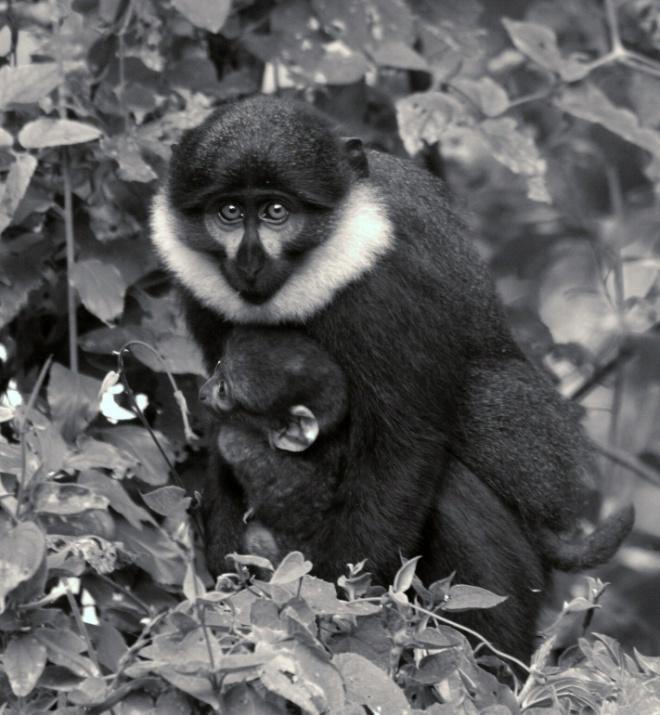Tharcisse Ukizintambara
In this project I analyse habitat characteristics, evaluate food availability and threats in relation to forest edge proximity and determine differences in behaviour between the edge and the interior groups.

An adult female l‟Hoest‟s monkey with her infant in the Bwindi forest. © A. McNeilage.
My project aims at investigating conservation implications of forest edge effects on behavioural ecology of l’hoest’s monkeys (Cercopithecus lhoesti)in Bwindi Impenetrable National Park (BINP). The edges of Bwindi forest are surrounded by one of the densest population of subsistence farmers in the world. Forest edges affect the behaviour of primate species in different ways. Some species may flourish on the forest edge because of food availability, becoming therefore ‘edge-thriving’; others, 'edge-sensitive species’ do not tolerate disturbances that occur on forest edges, while ‘edge-resilient species’ can balance between the energy spent foraging and that spent avoiding forest edge disturbances and risks. In this study, I explore the costs and benefits of living on forest edges for l’hoest’s monkey, a presumed edge-resilient species in BINP. I analyse habitat characteristics, evaluate food availability and threats in relation to forest edge proximity and determine differences in behaviour between the edge and the interior groups.
My results so far can be summarized as follows. The edge group is a regular crop raider. Only adults venture outside the park, while juveniles play “the sentinel” from the forest edge. At any alarm the raiders retreat back into the forest canopies in order to persecution by farm-guards, baboons, and feral and domestic dogs or also forest edge dwelling jackals. In contrast, the interior group usually avoids the forest canopy, where they are exposed to threats from the crowned hawk eagle, an interior forest raptor that preys on monkeys. When disturbed, individuals drop to ground from tree canopies, remain motionless and concealed under terrestrial vegetation cover. Ground predators such as leopards became extinct in BINP more than ten years ago. Compared with the edge group, the interior group forages more in association with other species—such as blue monkeys, black-and-white colobus monkeys, and even red duikers or guinea fowls to increase vigilance. Both edge and interior groups have similar sleeping sites. They sleep in mid-canopies densely covered by lianas and other climbers. These sites are usually near fruiting trees such as Prunus africana, Ficus spp., Sygyzium guinnense, Symphonia globulifera, etc
The results of this ongoing study will contribute to the understanding of the natural history of a little know and near threatened l’hoest’s monkey species and will provide relevant information that park managers could use to ensure the long-term conservation of a unique species and its montane habitat that is threatened by human activities and climate change.